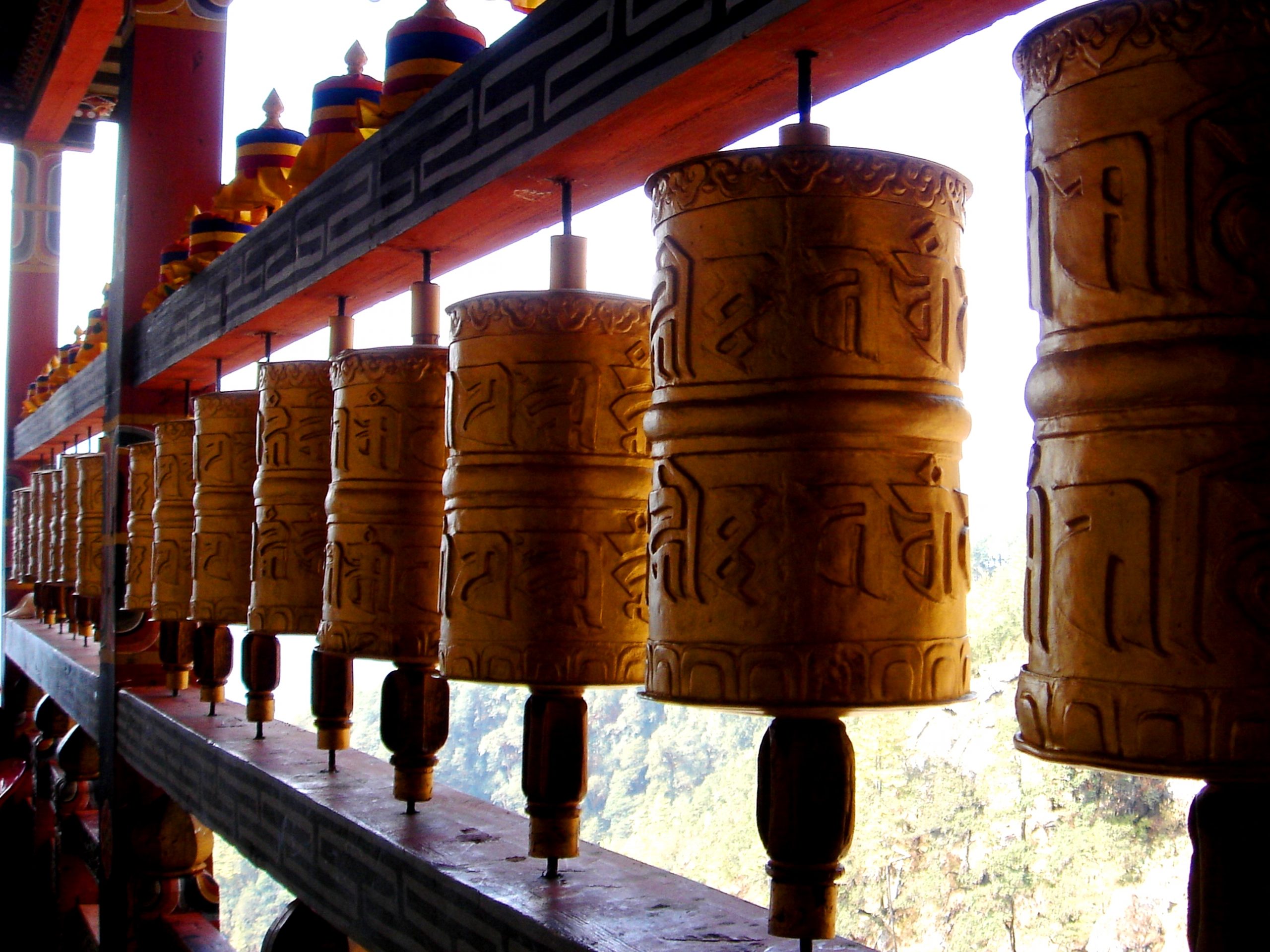Capturing the essence of Bhutan
Description
Duration: 8 nights/ 9 days
Destinations: Paro, Thimphu, Punakha, Gangtey Valley, Bumthang, Ura Valley, and Trongsa.
Attractions: sacred temples, monasteries and dzongs (forts), museums, festivals, hikes, and a spectacular view of the Himalayan ranges.
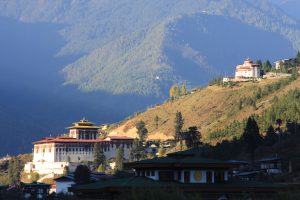 DAY 1: ARRIVAL AT PARO
DAY 1: ARRIVAL AT PARO
Touch down in Paro on the first day of your Bhutan photography tour and transfer to the city’s elegant old town. After some rest, we will take our first peek, capturing dramatic images of the valley from Ta Dzong, before walking down to Paro’s traditional center, Rinpung Dzong, to take photos of the monks in the courtyard. Next, we will visit the National Museum, located above the Paro Dzong in the ancient circular watch tower. It consists of six floors dealing with different aspects of Bhutanese culture. Afterward, we can stroll around the town for street photography.
Overnight-Paro
 DAY 2: PARO-BUMTHANG BY FLIGHT
DAY 2: PARO-BUMTHANG BY FLIGHT
Before our departure to Bumthang (yes, it sounds funny if you’re a native English speaker), we will start the day with a drive to Drugyel Dzong. This dzong was constructed in 1646 to commemorate the victory over Tibetan armies. Though the fortress was destroyed by a fire in 1951, the ruins remain an impressive sight. Here, we can capture the ruins of ancient Bhutan. The dzong is located overlooking paddy fields and the small village of Drugyel. Afterward, we can head to Ney Mey Zam (a traditional wooden cantilever bridge), which overlooks Paro Rinpung dzong, the National Museum. We will depart Paro and fly to the Bumthang Valley, the spiritual heartland of Bhutan. It is brimming with several precious and ancient Buddhist sites. Here, you’ll learn the art of great travel photography and create images few on the planet will have ever seen before. We’ll reveal skills to help you choose the best positions to make your images really stand out, how to compose correctly, and how to use light to the best effect. After check-in, we will stroll around Chamkhar town to get shots of the town. Here we can capture photos of local life in central Bhutan and see the contrast or similarities between Paro town and Chamkhar town. After lunch, we will visit Jakar Dzong, located overlooking the Chamkhar Valley. At the dzong, we will have the opportunity to take pictures of the beautifully designed dzong courtyard and take pictures of the landscape of Chamkhar Valley from above, learning to frame photos and play with light. In the evening, we will visit the grand Kurjey Lhakhang, located on plain land. Here you can take pictures of the temple and monastic life amidst the Bumthang Plain lands.
Overnight-Bumthang
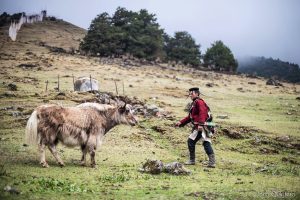 DAY 3: BUMTHANG - DAY EXCURSION TO URA AND LOCAL FESTIVAL
DAY 3: BUMTHANG - DAY EXCURSION TO URA AND LOCAL FESTIVAL
Today, we will travel towards the scenic Ura village in Bumthang. On the way, we will stop by Mebar Tsho, the Burning Lake located along the way to the Tang village over the feeder road under Bumthang Valley. Today, this small freshwater lake is a sacred pilgrimage site for the Bhutanese, with bright multicolored prayer flags surrounding it and a small altar dedicated to Terton Pema Lingpa has also been set up. Once we reach Ura village, we will experience a local
farmhouse lunch catered by a farmer in Ura. After lunch, you will tour local villages and work on a series of images that define the region. Explore Ura village, interacting with locals and creating interconnected photographs that would grace any travel magazine. We will work with the guide to get photographs of locals in their environment. On the way back, we will stop by the Yathra (yak/sheep wool) weaving center in Chumey, which is known for its Yathra weaving Yathra weaving is indigenous to Bumthang and is
delightfully woven embroidered cloth. Here we can capture the strong women of Ura working rhythmically to produce the famous products of their region. There will be a lot of color and textures to photograph here. After this, we drive back to the hotel.
Overnight: Bumthang
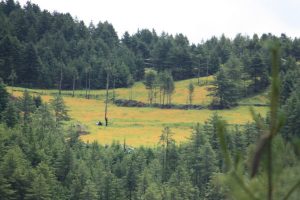 DAY 4: BUMTHANG - GANGTEY
DAY 4: BUMTHANG - GANGTEY
Early Drive to shoot the prayer flags at Yutong La Pass, then on to Trongsa. This is a high mountain pass at an elevation of 3.436m (11,272ft) above sea level, located in the Bumthang District of Bhutan. It is one of the highest mountain roads in the country. Decorated with colorful prayer flags, the pass is a sight familiar in Bhutan. Visit Trongsa Dzong, the ancestral home of the present Royal Family. It sits majestically with fabulous views of the Himalayas, with a sheer drop to the south that often just disappears into cloud and mist. The rambling assemblage of buildings comprises the dzong trails down the ridge and is connected by a succession of alley-like corridors, wide stone stairs, and beautiful paved courtyards. Over 200 novice monks live here, where we will try out new skills in reportage, shooting in situ images of life in a monastery, and then have our first show of images, reviewing each in detail. In the afternoon, drive to Gangtey and stop at the viewpoint to take pictures of the Trongsa dzong, the museum, and the village. We continue the scenic drive until we reach Chendebji Chorten. At the Chorten, we capture images of the stupa amidst prayer flags swaying in the wind. Against a backdrop of forest-clad mountains, the Gangtey Goempa temple complex rises dramatically from a cluster of hilltop cottages, only a few hours from Trongsa. One of the oldest Nyingma monasteries in Bhutan, Gangtey Goemba, has recently been renovated, and the fine workmanship of Bhutan’s best woodcarvers, sculptors, and painters here makes for fantastic photography. Here we take pictures of the quaint clustered village of Gantgtey. We will take a nature trail hike and explore the whole of Phobjikha Valley through a green, lush forest, passing by Samchuvara village and Khewang village.
Overnight: Gangtey (Wangdiphodrang)
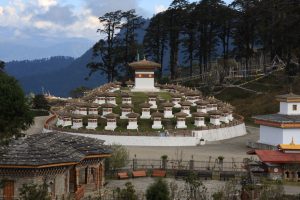 DAY 5: GANGTEY-PUNAKHA/THIMPHU
DAY 5: GANGTEY-PUNAKHA/THIMPHU
Today, we rise early to photograph the glacial valley of Phobjikha, considered one of the most beautiful landscapes in Bhutan. Along the way, you will capture vistas dotted with prayer flags, local hamlets with authentic, characterful faces, and fields covered in dwarf bamboo. Then we drive towards Punakha, where we will visit Chimi Lhakhang, the Temple of Fertility. It was built by Lama Ngawang Chogyal and dedicated to Drukpa Kuenley (also known as the Divine Madman) in the 15th century. Here we will find monks, rows of prayer wheels, and beautiful slate carvings. Also, the Bodhi tree here is believed to have been brought from Bodhgaya. This is a photographer’s paradise. In the evening, we will capture photos of Punakha Dzong and the river. OR In the afternoon, after lunch, drive to Thimphu via Dochula Pass (3150 m), visit Druk Wangyel Chorten (108 stupas), and on a clear day, you will have a spectacular view of Jigme Singye Wangchuk Himalaya Range. In the evening, drive to Thimphu, the capital city.
Overnight: Punakha/Thimphu
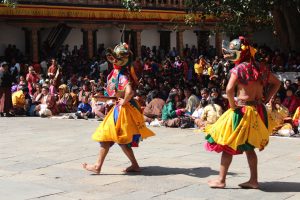 DAY 6: PUNAKHA, TALO TSHECHU IN 2024 (FESTIVAL), THIMPHU TSHECHU
DAY 6: PUNAKHA, TALO TSHECHU IN 2024 (FESTIVAL), THIMPHU TSHECHU
Talo Tshechu is held for three days at Talo Monastery, and this festival is well known for its unique mask dances and Atsara (clown) dances. Another popular attraction is Zhungdra (classical dance) performed by a local dance troupe, which has deep religious and historical significance. Talo Tshechu is a community-based annual mask dance festival. The mask dances, known as (Cham) folk dances, are performed to bless onlookers and to teach the Buddhist dharma. People from all the villages nearby come to gather early in the morning at the festival grounds with their families. This is a good opportunity to capture the locals in their colourful outfits, adorned in silk and heavily embroidered clothing. The locals dress in their finest outfits and jewelry, watching sacred mask dances in an arena, and this is a great opportunity to capture the Bhutanese celebrating and enjoying life. Masked dancers will perform throughout the day, and here you will have the opportunity to capture the bright colors and graceful movements of the Bhutanese culture.
Overnight: Punakha
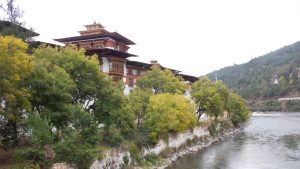 DAY 7: PUNAKHA-THIMPHU/THIMPHU- PARO
DAY 7: PUNAKHA-THIMPHU/THIMPHU- PARO
We will take an early morning drive towards Dochula to take some pictures of the 108 stupas. Upon reaching Thimphu, we’ll visit Buddha Point and Buddha Dordenma, the tallest Buddha statue in Bhutan, overlooking Thimphu Valley. You can take a picture of the whole of Thimphu city. Memorial Chorten We will drive back and visit the memorial stupa built in 1974 in memory of Bhutan’s third king, His Late Majesty, King Jigme Dorji Wangchuk, who is popularly regarded as the father of modern Bhutan. The paintings and statues inside the monument provide a deep insight into Buddhist philosophy. Here you can capture images of devout Buddhists (usually the elderly) circumambulating the stupa, lighting butter lamps, and praying. After lunch, we visited Takin Preserve. Motithang Takin is the national animal of Bhutan. Legend has it that the animal was created by the great Buddhist yogi, Drupa Kunley, and it can be found only in Bhutan and nearby areas. Taxonomists place the animal in a category of its own as it is not similar enough to any other animal to fit established categories. The Takin preserve is in the lush forests of suburban Thimphu. Here you can venture a little further up to take pictures of Thimphu town from the BBS viewpoint. Weekend Market Every Saturday and Sunday most of Thimphu's scant population and many valley dwellers congregate on the banks of the river, where the weekend market is held. It is an interesting place to visit and provides an opportunity to take photographs of the busy local vegetable market with vibrant colors from the fresh produce to the lively characters selling their products.
Overnight: Thimphu/Paro
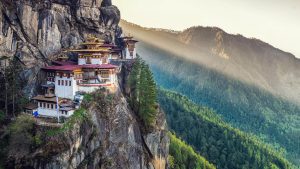 DAY 8: THIMPHU-PARO (TAKTSANG EXCURSION)
DAY 8: THIMPHU-PARO (TAKTSANG EXCURSION)
Today we take an early drive to the famous Tigers Nest Monastery (Taktshang), an hour and 20 minutes drive from Thimphu to the Taktsang base. We will hike up to Taktsang on foot, which is a reasonable climb. Taktshang (Tiger's Nest) evolved in 747 AD when Guru Padmasambhava chose a cave on a sheer rock face to meditate and, assuming a wrathful form, Guru Dorji Drolo, a stride tigress, subdued the evil spirits in the locality. Taktshang thus became one of the most important Buddhist monuments in the Himalayan Buddhist world. The steep hike here provides many different opportunities for photographs, from tree-covered areas to endless steps towards the monastery, which is a stunning view clinging to the side of a cliff. After the refreshing hike, we will head to Kichu Lhakhang to light butter lamps. In an ideal practice, one does not simply light a butter lamp but must also pray that ‘’ as one lights this butter lamp, one is lighting wisdom for the world and dispelling the darkness of the world”. The offering of the butter lamp is the offering of wisdom and the light of knowledge to eradicate darkness or ignorance.
Overnight: Thimphu
 DAY 9: DEPART PARO
DAY 9: DEPART PARO
This is the end of our journey together! In the early morning, our guide and driver will accompany you to the airport for the departure and wish you happy traveling and fond memories.

